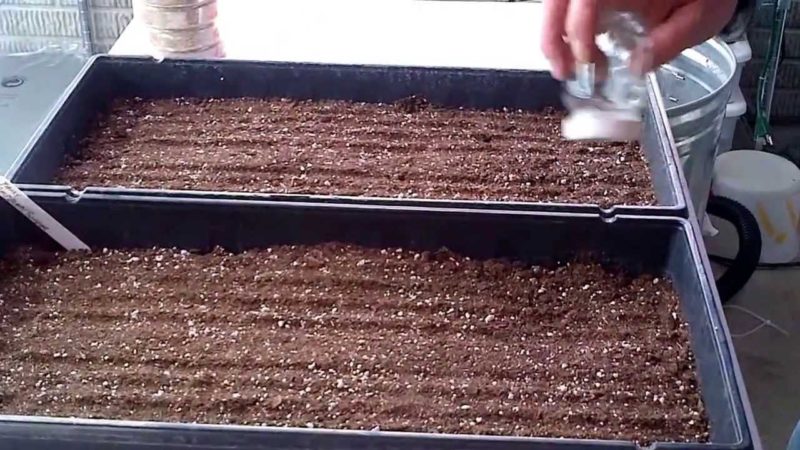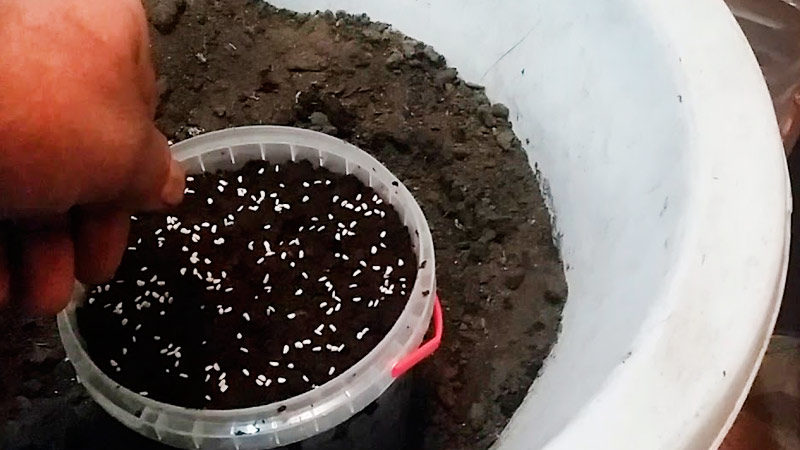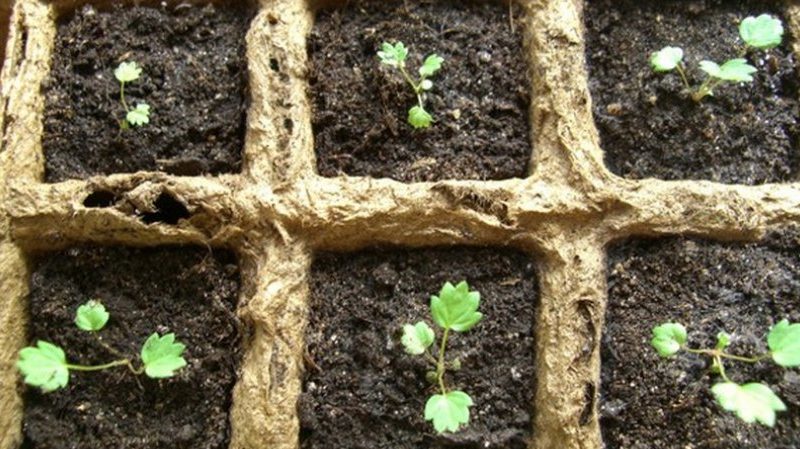A beginner's guide: how to grow raspberries from seed for seedlings at home
When propagating raspberries, vegetative methods are often used, without risking growing it from seeds. At the same time, seed reproduction has a number of advantages, in particular, it allows you to control the quantity and quality of seedlings and plant them at a convenient time. We will tell you about how to grow seedlings from raspberry seeds at home.
The content of the article
Is it possible to grow raspberries from seeds at home
When growing raspberries from seeds, the basic rules are followed:
- use high-quality planting material collected independently or purchased from a specialized store;
- choose suitable grade and the time of sowing the seeds;
- use a suitable soil mixture;
- dive in time;
- provide seedlings proper care.
We will tell you more about each rule.
Important! Good quality raspberry seeds should be small and hard, oval-round and yellowish-white in color.

Advantages and disadvantages of propagating raspberry seeds
The advantages of the seed propagation method for raspberries:
- there is no need to harvest cuttings, which is important when breeding raspberry varieties, for which it is difficult to find strong "offspring";
- the likelihood of getting another plant, unlike the mother;
- saving time and money in case of self-harvesting of seeds.
Minuses:
- the need to create special conditions for seed germination;
- high probability of getting an unexpected result;
- the need for seedlings to comply with specific agrotechnical requirements.
Suitable varieties
Almost all varieties are suitable for growing from seeds, but those that are characterized by large-fruited and a long fruiting period are especially popular. Also, when choosing, they are guided by the climatic conditions of the region, the soil composition, the ripening period of berries and the yield.
For planting in the middle lane and southern regions of Russia, the following varieties are suitable:
- Polka. The variety is represented by medium-sized shrubs that are resistant to fungal diseases and viruses, but do not tolerate frost or excessively high temperatures. Fruiting - twice a year, yield - up to 4 kg per bush.
- Hercules. Sprawling shrubs, reaching a height of 2 m. Fruiting - twice a year, berries weigh about 6 g each, acid is felt in the taste. Productivity - up to 3 kg per bush.
- Zyugan. Bushes are strong, erect, do not need a garter and do not have thorns. Fruiting begins in July. The mass of berries reaches 12 g, the yield is up to 9 kg per bush.
- Primara. The bushes are medium-sized, frost-resistant. The berries weigh an average of 10 g and taste sour.
Cultivars suitable for growing in the northern regions:
- Bryansk miracle... A frost-resistant and high-yielding variety. The berries ripen in August. Productivity - up to 4 kg per bush.
- Caramel. Erect bushes that bear fruit from the first year. The berries are dense and sweet, reaching a mass of 12 g. Productivity - up to 5 kg per bush.
- Yellow giant. The bushes grow up to 2 m in height, the berries are yellow, each weighing about 8 g, characterized by a sweet taste and a bright aroma. Productivity - up to 4 kg.
High-yielding raspberry varieties also include Patricia, Izobilnaya, Mirage, Red Ruby, Gusar.
How to get seeds from raspberries
For self-collection of seeds from a bush, berries are picked, thoroughly cleaned of debris, rubbed through a sieve, and the resulting cake is poured with water. Then remove all floating pulp and seeds unsuitable for sowing, and the grains remaining at the bottom are washed several times with water and soaked for a day to swell.
Some gardeners dry the cake by spreading it in one thin layer on a cloth and leaving it in a bright, well-ventilated place.
Important! Seeds are harvested only from fully ripe berries without rot and damage.
How to germinate them

Sowing of non-germinated raspberry seeds is also allowed, but preliminary preparation of the planting material accelerates its germination and increases the chances of obtaining a positive result.
Germination allows you to get rid of unsuitable seeds for sowing and shorten the time of emergence.
The seeds are laid out between two layers of wet gauze and removed in a dark and warm place for 2-3 days. During this time, the cheesecloth is regularly moistened without drying out.
Successful germination is impossible without correct stratification, that is, creating optimal conditions for the preparation of seed. If sowing is planned in spring, the seeds are folded into a fabric or nylon bag, moistened and put into the refrigerator. The seed is regularly sorted out and made sure that it does not dry out.
Reference. The optimum temperature for stratification is + 1 ... + 5 ° C.
Other stages of preparation for sowing
Seeds before germination process with a solution of fungicides (Alirin-B, Gamair) to minimize the risk of developing diseases, and growth stimulants (Zircon, Kornevin) for early germination.
To germinate seeds and get strong and healthy plants, choose the right pots and substrate.
The container for sowing seeds should be a maximum of 15 cm deep. The best option is a special plastic seedling pot with drainage holes.
Raspberries prefer a substrate rich in nitrogen and potassium. To prepare soil suitable for seedlings, garden soil, peat and sand are mixed in equal proportions.
Planting dates for seeds
Seeds for seedlings are sown in the first week of March. In autumn (September - October) they are sown directly into open ground. However, in both cases there are advantages and disadvantages.
Pros of spring sowing:
- the ability to use only high-quality seeds in the case of preliminary germination;
- providing seedlings with proper care when grown in a greenhouse or indoors;
- the possibility of planting seedlings in the ground immediately after the end of the frost.
Minuses:
- the need for sprouts for additional lighting;
- the need for proper conditions for storing seeds;
- risk of root damage when transplanting.
When sowing in autumn, it is not necessary to grow seedlings, store the seed and create special conditions for stratification. Young plants are more resistant, they are not transplanted, so there is no risk of root damage.
At the same time, it is impossible to predict how many seeds will sprout, and some of the young plants die due to spring frosts.
Landing technology

Seed planting scheme:
- pour a suitable soil mixture into previously prepared containers;
- distribute raspberry seeds over the surface of the substrate, deepening by 0.5-0.7 cm;
- sprinkle them with sand;
- cover the container with polyethylene and remove it in a bright place, while excluding direct sunlight.
Seedling planting process:
- in a previously prepared area, dig out planting holes at a distance of at least 15 cm from each other;
- pour 100 g of ash and humus on the bottom of each hole;
- moisten the container with seedlings;
- remove the seedlings from the container, place them in the center of the holes;
- sprinkle with earth, lightly tamp and water.
Seedlings are transplanted into open ground when the average daily air temperature is set at + 15 ... + 18 ° C.
Further care
When watering seedlings, they are guided by the state of the upper soil layer - it must not be allowed to completely dry out... The earth is watered with water at room temperature, on average, once every 3-5 days. Fertilizers in the form of a urea solution are applied every 10 days.
After planting seedlings in the ground, they closely monitor that the earth does not dry out. This is a basic requirement for caring for raspberries during the first two seasons.
Also, the plantings are weeded and loosened weekly - this improves the moisture permeability and aeration of the soil.
Fertilizers are applied after the snow melts (urea or saltpeter), after loosening (compost or peat - 0.5 buckets per 1 sq. M), in May (mullein solution 1: 4) and during the period of setting the ovary (for 10 liters of water 60 g superphosphate and 10 g of urea).
Important! All feeding applied only after loosening and watering.
As a prophylaxis of infections in rainy weather, the plants are sprayed with a solution of Bordeaux liquid twice a month.
Stages of growing seedlings before planting in the ground
The first shoots appear 20-25 days after sowing the seeds, which must be preceded by selection, germination and processing.
If the planting material was sown frequently, after the appearance of 1-2 true leaves on the sprouts, the seedlings dive into separate containers. Otherwise, the plants will not receive enough light and will slow down in development.
A few weeks before planting in the ground, the seedlings begin to harden. To do this, the container with seedlings is taken out onto the balcony or street, first for 10 minutes, gradually increasing this time.
When 2-4 leaves are formed on the seedlings, they are planted in the ground.
Experienced gardening tips

Experienced gardeners recommend:
- harvest raspberry seeds in September - this is the optimal harvesting time;
- use only large, ripe berries without damage to collect seeds and make sure that the bush itself is healthy;
- after planting seedlings in spring, mulch the soil around the holes with sawdust;
- cover the seedlings if frost is expected.
Conclusion
Growing raspberries from seeds is the most time consuming way to propagate a crop. In order for the efforts made to bring a positive result, use high-quality planting material, observe the terms and rules for sowing seeds and provide the seedlings with proper care.